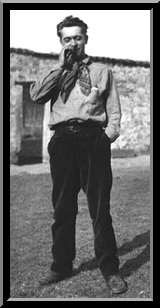
Biographical Notes
by
Stephen Pain
Hart (Harold) Crane was born on 21 July 1899 in Garretsville, Ohio the son of Clarence Arthur Crane and Grace (nee Hart) Crane. His family moved to Dayton and then to Cleveland. His father became the owner of a large candy manufacturing company. Crane wrote verse from the age of thirteen. When he was seventeen Hart spent a year with his mother at her father's plantation in the Isle of Pines, Cu ba. Upon his return he met Mrs. William Vaughn Moody, the widow of the poet. In 1916 his first poem "C33" was published in "Bruno's Weekly". Shortly afterwards Clarence divorced Grace. The divorce had a catastrophic effect on the young Cran e and was undoubtedly a factor in the development of his creative genius. He left for New York where a friend of the family, Carl Schmitt, introduced Hart to a circle of friends including Alfred Kreymborg and Maxwell Bodenheim. A novel was started but was soon given up. He complete the poem "The Bathers." In 1918 he became the associate editor of a journal called, "The Pagan". Hart tried to enlist for military service but was rejected. He was employed as a reporter on the Clevelan d newspaper "Plain Dealer". Later in 1919 he moved to writing advertising copy and became the manager of "The Little Review". He moved on to Rheinthal and Newman Agency before accepting reluctantly a clerkship in one of his father's candy stores in Akron, Ohio. He worked for his father for a year. The desire to write poetry was however irresistable and he left his father's business so as to establish himself as a poet. He completed "The Tambourine" in 1920. To support his poetry he took on advertising work for Corday & Gross in Cleveland. He continiued to make friends among artists and writers. In 1923 he left Cleveland for New York and lived in Greenwich village with Gorham Munsen. He became friends with Waldo Frank, a novelist and critic, who was to play an influential role in the rest of his short life. Frank helped him to find work with J. Walter Thompson Advertising Company. The following year Hart worked for Sweets Catalogue Service and moved into a room that was once lived in by the Brooklyn Bridge architect, Roebling. He started work on his poem "The Voyages" the same year. He was fortunate to meet Otto Kahn a wealthy banker and philanthropist who provided money ($1,000) so that Hart could concentrate on writing his most famous poem, "The Bridge." Allen Tate, the poet and critic, and his wife Caroline provided Ha rt with accommodation in their home in Patterson, New York. In 1926 he travelled with Waldo Frank to the Isle of Pines (Cuba) and worked there on his poetry before he was forced out by a hurricane which demolished his grandfather's plantation home. Back in New York he saw his first book of poems published: "White Buildings" by Liveright in December of that year. He returned in 1927 to Patero n, New Jersey and started work on "The River." He worked in 1928 as a travelling secretary to Herbert Wise, a stock-broker, on Wise's trip to California. Decembe r in the same year he sailed for Europe ostensibly to work on "The Bridge." In Paris he led a decadent life, one which he realized himself was not conducive to writing. He returned to New York in July of 1929. The first edition of "The Bridge" was published in Paris in a limited edition, (the Black Sun edition) and three month s later in April 1930 Liverights published the first American edition. Hart worked for a short time for "Fortune" magazine. He was awarded a Guggenheim Fellowship and with his success he sailed for Mexico with the intention of writing a Latin-American equivalent of "The Bridge". In Mexico he joined an artist's colony in Mixcoac that included writers and artists like Katherine Anne Porter, David Alfao Siqueiros and Malcolm Cowley's ex-wife. Peggy Baird with whom Hart lived. After the death of his father, Hart returned to the United States so as to settle the estate. Hart took his own life by jumping overboard the "Orizaba" two minute s before twelve noon on Wednesday, April 27th, 1932.